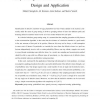Free Online Productivity Tools
i2Speak
i2Symbol
i2OCR
iTex2Img
iWeb2Print
iWeb2Shot
i2Type
iPdf2Split
iPdf2Merge
i2Bopomofo
i2Arabic
i2Style
i2Image
i2PDF
iLatex2Rtf
Sci2ools
CORR
2010
Springer
2010
Springer
Group Testing with Probabilistic Tests: Theory, Design and Application
Identification of defective members of large populations has been widely studied in the statistics community under the name of group testing. It involves grouping subsets of items into different pools and detecting defective members based on the set of test results obtained for each pool. In a classical noiseless group testing setup, it is assumed that the sampling procedure is fully known to the reconstruction algorithm, in the sense that the existence of a defective member in a pool results in the test outcome of that pool to be positive. However, this may not be always a valid assumption in some cases of interest. In particular, we consider the case where the defective items in a pool can become independently inactive with a certain probability. Hence, one may obtain a negative test result in a pool despite containing some defective items. As a result, any sampling and reconstruction method should be able to cope with two different types of uncertainty, i.e., the unknown set of def...
| Added | 09 Dec 2010 |
| Updated | 09 Dec 2010 |
| Type | Journal |
| Year | 2010 |
| Where | CORR |
| Authors | Mahdi Cheraghchi, Ali Hormati, Amin Karbasi, Martin Vetterli |
Comments (0)

